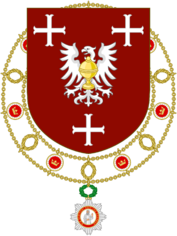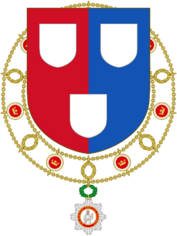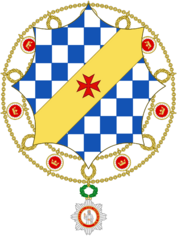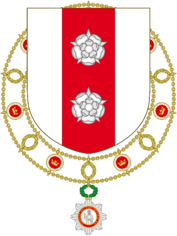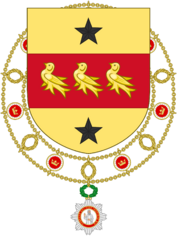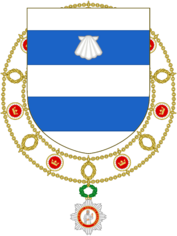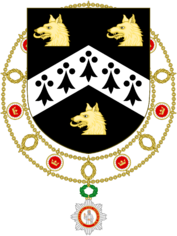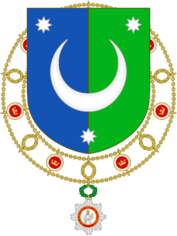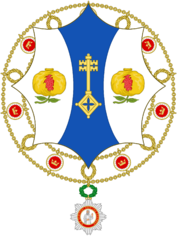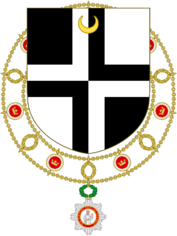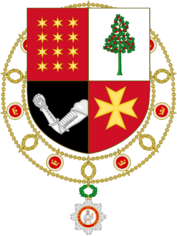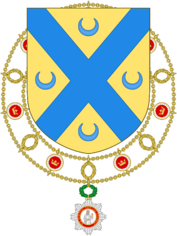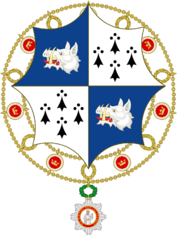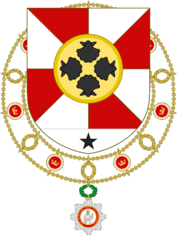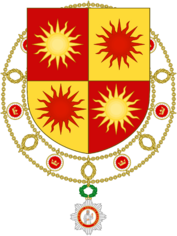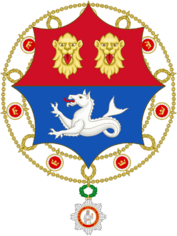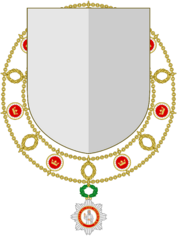Order of Pious Lot
The Order of Pious Lot, formally the Benevolent Hospitaller Order and Society of Pious Lot and of the Righteous (Esperanto: Bonfara Hospitalisma Ordeno kaj Societo de Pia Lot kaj de la Justuloj) and also known as Pious Lot International, is an order of chivalry and charitable organisation constituted in XXXX by charter from TBD and dedicated to Lot, a holy figure in the Abrahamic religions.
The order is found throughout the world, with a general mission "to promote and enhance wellbeing, to prevent and relieve sickness and ill-health, to enhance opportunities, and to enable education and learning.' The order has approximately 27,000 members, called attendants, who work to promote the interests of the order and further its mission. As a secular order with only nominal religious affiliation, attendants come from various religious groups and denominations. Membership is by invitation only.
The Order of Pious Lot is best known today for its education and wellbeing organisations and initiatives. These include Pious Lot Learning Group and the Brigades of Pious Lot. Since 1972, the order has been a non-governmental organisation with charitable status in a number of countries.
Organisations and facilities
The Order of Pious Lot, through its charitable foundation Pious Lot International, oversees a large number of organisations providing specialist services. These services are overseen by a Board of Trustees, which was founded in 1972 and replaced the Under-Chancellery for Scrutiny, headed by a Chairman appointed by the Central Chancellery.
Brigades of Pious Lot
The Brigade of Pious Lot (alternatively and commonly known simply as "The Brigades") is the name of a collection of affiliated first aid and emergency medical services. The individual brigades are overseen by the order and its companionates (national branches), and are staffed with a mixture of paid and voluntary personnel.
Brigades, in some countries, help to staff hospitals and other medical centres alongside existing medical staff. Plans for the creation of specialist brigade hospitals were proposed as far back as the 1910s, but a policy enacted in 1921 has seen the brigades committed to work within and alongside "pre-established medical services" and the prohibition of "activities resulting in the division of medical and other resources."
Brigades use a comprehensive ranking system. Before 1926, this was based on grades within the wider order, but was modified and modernised to align with policing and other such rank structures.
Structure
The Order of Pious Lot is organised as a chivalric order and its structure is thus modelled on other similar orders. There are seven officers (including the Grand Master):
- Chancellor and Principal Grand Companion: Frederik Lund Lauritsen GKPL
- Chaplain: Rev. Frank Allaway GKPL
- Registrar and Secretary: Carolina Nogueira GKPL
- Treasurer: Erramun Gaztañaga GKPL
- Usher: Joe Symons GKPL
- Herald: Dr. Daram val Zusz GKPL
The Grand Master is at the apex of the order, and it is by the Grand Master that appointments to the order are made and international representation principally conducted. The seven officers of the order collectively constitute the Central Chancellery (officially the Central Chancellery of Officers).
The Central Chancellery is the principal decision-making body of the order, described in the order's constitution as the "central body for administration and regulation." Each officer is charged with distinct functions, although only the Grand Master, Chancellor, Registrar and Secretary, Treasurer, and Herald maintain responsibilities beyond pure ceremony. The Usher and Chaplain, although remaining occupied and considered senior positions, are largely ceremonial posts with limited duties.
Grades
After the officers of the order follow members, who are divided into five hierarchical grades, all having accordant post-nominal letters Grade I is limited to only the members of the Central Chancellery plus no more than 18 others, though royalty and heads of state of any country may be appointed as a Grand Companion without counting towards the complement. All priors, should they not already be in the grade or higher, are made a Companion of Mercy upon their assignment.
| Grades of the Order of Pious Lot | |||||
|---|---|---|---|---|---|
| Grade | Grade I | Grade II | Grade III | Grade IV | Grade V |
| Title (Anglish) | Grand Companion | Companion of Mercy | Companion | Officer | Member |
| Title (Esperanto) | Granda Kunulo | Kunulo de Kompato | Kunulo | Oficiro | Membro |
| Post-nominal letters | GKPL | KKPL | KPL | OPL | MPL |
Grand Companions receive the accolade through a ceremonial washing of the hands (formerly the feet) to symbolise their purity as they enter the senior grade of the order. They are then given their robes and insignia. Although not granted any title, they may use post-nominal letters dependant on the regulations of their home country (although they are entitled to use them within the order), and may also (dependent on regulations) petition for the order's inclusion in a coat of arms. There is the addition of "Friend of the Order", which entitles membership but is not a grade in itself, and is granted to employees of the order.
From time to time, individuals are appointed to a higher grade within the Order, thereby ceasing usage of the junior post-nominal letters.
Courage
Although the order explicitly disavows violence, it nonetheless recognises acts of bravery and courage undertaken during times of conflict. Such awards are made to individuals for acts worthy of merit but which were done in "circumstances of significant threat to personal health and wellbeing." Such awards are officially differentiated by the addition of a small silver cross to the ribbon, and the inclusion of the letters "Gal." to the post-nominals. The full designation for these awards is "Companion, Officer, or Member of the Order of Pious Lot for Courage", as opposed to "for Distinguished Service" for other awards.
Any individual who is inducted into the order for courage division may be further inducted into the order as an ordinary member. Where both inductions are to the same grade, the recipient uses only one post-nominal designation. Where the two inductions are to different grades, both post-nominal designations are used. For example, an individual who is a Companion of the Order both for Courage and for Distinguished Service uses only the post-nominals KPL. An individual who is a Companion of the Order for Distinguished Service and an Officer of the Order for Courage may, however, use the letters KPL OPL (Gal.) Regardless of grade, inductees to both divisions may wear all decorations.
Vestments and insignia
Upon admission into the Order of Pious Lot, attendants are presented with appropriate insignia, each level and office being depicted by different emblems and robes for wear at important occasions for the order. Common for all members of the Order is the badge, consisting of a central image of Lot within a red circlet bearing the order's motto. This is placed atop a star, the design of which depending on grade.
| Insignia of the Order of Pious Lot | ||||||
|---|---|---|---|---|---|---|
| Grade | Grand Companion | Companion of Mercy | Companion | Officer | Member | |
| Insignia | 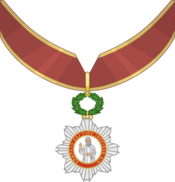 
|
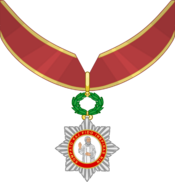 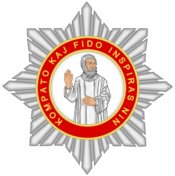
|

|

|

| |
All Grand Companions may wear their badges at the left hip on a 101.6 millimetres (4.00 in) (for men) or 82.5 millimetres (3.25 in) (for women) wide, watered silk ribbon over the right shoulder and from a 16.5 millimetres (0.65 in) wide band at the collar. Grand Companions, Companions of Mercy, and Companions of both sexes wear their badges on a 16.5mm wide ribbon at the neck, while Officers and Members wear theirs on a 38 millimetres (1.5 in) straight ribbon suspended from a medal bar on the left breast. Grand Companions and Companions of Mercy may also wear a breast star, which appears the same as their badges (for Companions and Companions of Mercy) and with a slightly altered star backing (for Grand Companions). Grand Companions' breast stars are 88.9 millimetres (3.50 in) in diameter, whilst Companions of Mercy and Companions are 76 millimetres (3.0 in). Further, all members of all grades are also given a button for wear on the lapel of non-formal civilian clothing, for events such as business meetings of the order. In general, the insignia of the Order of St John may be worn at all occasions where other decorations are worn, not only those connected with the ceremonies of the order.
All members of the order are also required to wear specific robes for formal occasions of the society, including a mantle, sopra vest, and hat. The mantles of the Grand Master and Grand Prior are all of red silk velvet, with sleeves, and lined with grey silk, the Grand Master's mantle is differentiated by an additional train and white lining. Other members, regardless of grade, wear the same red mantle without lining and without sleeves. Each cloak also bears on its left side a rendition of the order's emblem.
The sopra (or supra) vest is a long drape of thin, red cloth that buttons close down the neck and to one side, falling to the ankles and cut so as to entirely cover the body. It is similar to a cassock, though it is actually derived from the supra vesta—a red surcoat worn in the mid XXth century by the XXXX.
Eligibility and appointment
The Grand Master confirms all appointments to the order as they, in their absolute discretion, shall think fit, though the constitution does impose certain limitations: the maximum number of members is set at 35,000, appointees may not be under the age of 18, and all appointments must have the support of the Priory. Recommendations are made by the Under-Chancellery for Appointments and Investitures and those selected have generally acted in such a manner as to strengthen the spirit of mankind.
To be inducted, new members must recite the organisation's declaration of intent:
- "I do solemnly declare that I will be faithful and obedient to The Order of Pious Lot and its Grand Master as far as it is consistent with my duty to my [sovereign/president] and to my country; that I will do everything in my power to uphold its dignity and support its charitable works; and that I will endeavour always to uphold the aims of this order and to conduct myself as a person of honour."
Removal
A person may be removed as a member of the order by resolution of the Under-Chancellery for Appointments and Investitures. The Central Chancellery, on occasion of such recommendation, meets in an extraordinary session to deliberate. The decision to remove a person from the order is recognised in the order's constitution as "the most significant step that may be taken [by the order] in response to misconduct and behaviour that actively injures the reputation of the Order and its members." Removal requires the unanimous approval of the Central Chancellery and becomes official when the Secretary registers a resolution to that effect.
Removal is rare, and is limited to the following circumstances:
- Conviction for an offence wherein the punishment exceeds 12 months imprisonment.
- Acts committed contrary to the principles of the Order.
- Acts of harm (verbal or physical) towards another member, either over a sustained period of time or on one occasion meriting serious penalties.
Any person removed from the order may be readmitted, but the heighest grade they may receive is Companion.
Heraldry
Grand Companions, Companions of Mercy, and Companions may display a circlet denoting their membership of the Order. Grand Companions display a representation of the collar of the order, whereas Companions of Mercy and Companions show the ribbon of the order as worn around the neck. Prior to 1975, the order relied on national heraldic authorities approving the incorporation of the order's insignia into an achievement, having no heraldic authority in its own right. Following reforms that year, the office of Herald (officially Herald and Principal Keeper of the Armorials and Achievements) was established, which approves coats of arms for use within the order and, in some circumstances, outside it.
Coats of arms are regarded in the order as a symbol of posterity and a commitment to the order. Possessors of arms granted by the order are required to make a further oath of fidelity and commitment to the order. Since 1998, wives of members possessing a coat of arms issued by the order may petition for the creation of their own coat of arms. Sons and daughters of members possessing arms may use these arms differentiated according to the standing rules of the order.
In the chapel of the order, the coats of arms of living Grand Companions are displayed on wooden panels. Panels bearing the arms of deceased members are moved into a small room adjacent to the chapel, and which are stored for the posterity of the order and its members.



